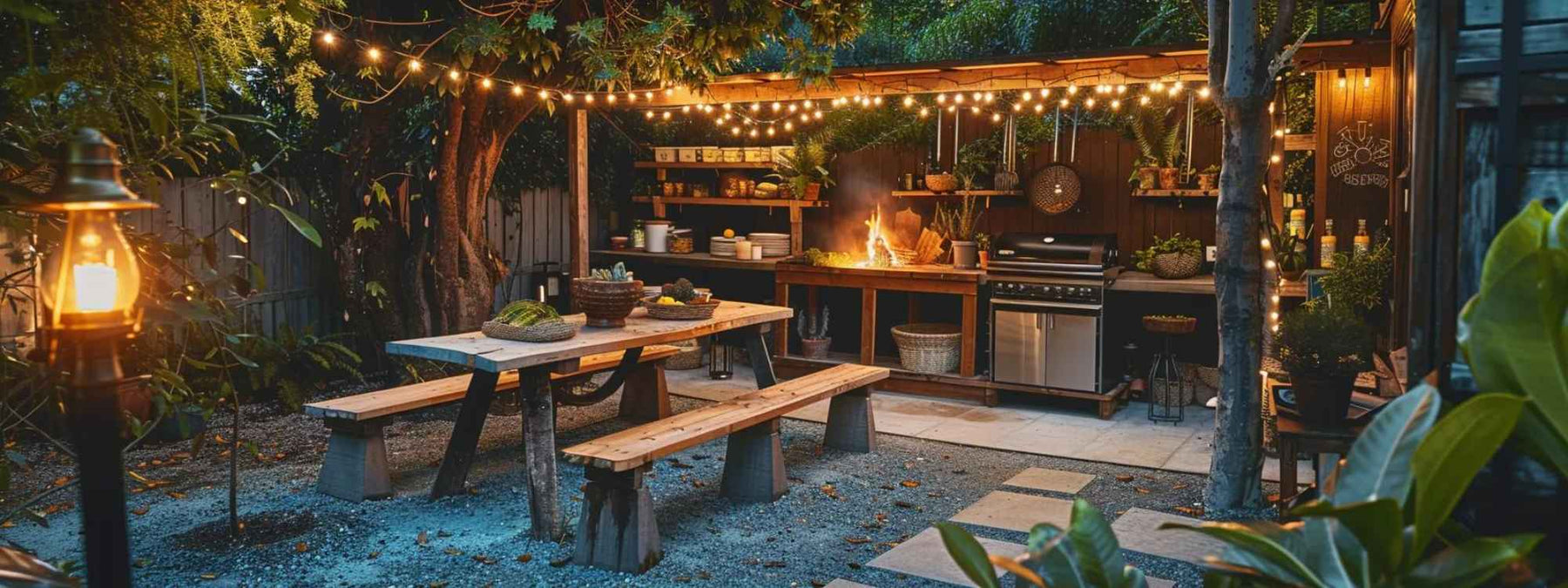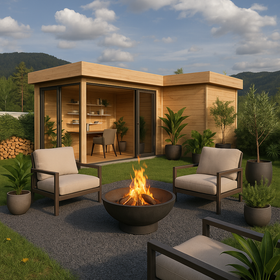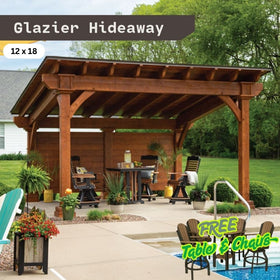512-777-0154

7 Must-Have Features in a Backyard Cooking Station Setup
So, you’ve got the barbecue grill.
Maybe even a refrigerator and a few folding chairs that wobble more than they should.
But if you’ve ever tried cooking an entire meal outdoors — prepping, grilling, plating, and maybe keeping guests entertained at the same time — you’ve probably noticed something’s missing.
An outdoor cooking station isn’t just a place to flip burgers. It’s a setup. A space that works with you, not against you. One that lets you prep, cook, serve, and hang out without sprinting inside every five minutes for a knife, a plate, or the paper towels.
It’s about making your setup practical and usable.
We’re going to walk through 7 essential features every backyard cooking station needs — the kind that make your life easier and your outdoor space more enjoyable.
1. A Dedicated Prep Space
Trying to prep dinner on a flimsy side table or your knee isn’t just annoying. It’s a mess waiting to happen.
If you're building an outdoor cooking station, a proper outdoor cooking prep station isn’t a luxury. It’s the foundation. Without it, everything else gets harder.
You need a flat, sturdy surface right next to your barbecue grill. Somewhere to chop, season, and organize without juggling cutting boards or balancing ingredients on the grill lid.

Ideally, this means countertop space that holds up outdoors. Think stainless steel, butcher block sealed for the weather, or stone that doesn’t mind the heat like Sunstone Tango 7ft Outdoor Grill & Cabinet Island Package.
Bonus points if you can sneak in extras like under-counter storage or a built-in cutting board. Even a slide-out trash bin can save you a trip back inside.
The goal is simple: less running around, more cooking where you stand.
2. Built-In Storage
Think drawers, cabinets, or sealed bins that stay outside full-time.
Materials matter here — stainless steel, resin, or sealed wood hold up better in the sun and rain. Look for rust-resistant hardware and finishes like the ones used for Sunstone Savanna 8.5ft Wet Bar Outdoor Island Package that don’t fade after one summer.
Storage isn’t just for tools, either. Keep your go-to spices, grill brushes, cutting boards, and even trash bags right where you need them in your outdoor kitchen. You can even tuck a small bin underneath the counter for quick cleanups.
The point is to make your outdoor cooking setup self-sufficient.
3. Reliable Cooking Equipment
It’s easy to get caught up in the outdoor kitchen design. Counters. Lighting. Maybe even a mini fridge.
But the equipment you cook on? That’s what makes or breaks your setup.
At the very least, you need a solid grill. Built-in gas models like Alfresco Grills 42″ Luxury Grill Standard Cart Model are the go-to for most backyard stations — they’re fast, consistent, and easier to manage than charcoal.
If you like slow-cooked ribs or wood-fired flavor, a smoker might be worth adding.
Got space? Look into an Alfresco Grills 30" Pizza Oven Plus - Countertop Model or flat-top grill.
Some setups let you mix and match. Modular systems or dual-fuel options give you flexibility without turning your patio into an appliance graveyard.
One thing to keep in mind: ventilation matters. Especially if you’re installing under a Brookside Timber Frame Timber Resort Pergola or roof. Smoke needs somewhere to go.
Also, think about where you’ll stand, how the heat flows, and whether there’s space to set things down mid-cook. It’s a cooking station, not a juggling act.
Choose equipment that fits how you like to cook.
Function first.
4. A Sink
Running water outside saves you from the constant back-and-forth to the kitchen. You can rinse veggies, wash your hands, clean a sticky spatula in your Sunstone Intermediate 9ft Outdoor Grill & Cabinet Island Package— all without leaving the grill unattended.
Plumbing does add a layer of complexity. But it doesn’t have to mean tearing up your backyard. If a full hookup isn’t in the cards, look into portable sinks or gravity-fed systems. Some even connect to a standard garden hose and drain into a bucket.
Not as sleek, but surprisingly effective.
And yes — hygiene matters. You don’t need a lecture on food safety, but having a way to wash up between tasks just makes things simpler (and cleaner).
5. Shade and Shelter
LuxCraft Umbrella might do the trick for short sessions. But if you’re building a real cooking station, it’s worth thinking bigger. Pergolas, retractable awnings, and shade sails all offer decent coverage without turning your yard into a dark cave.

When it comes to materials, look for something that handles heat, rain, and UV rays without falling apart after a season. Powder-coated metal, treated wood, or heavy-duty fabrics usually hold up better.
Shade keeps you cooking longer, and shelter makes the space usable even when the weather doesn’t cooperate.
6. Lighting That Works After Dark
Start with task lighting. This is the practical stuff — under-counter LEDs, grill lights, or motion-sensor fixtures aimed at your prep and cook zones. Anywhere you’re using a knife or fire should be lit properly.
Then there’s ambient lighting. Think string lights, solar lanterns, or small path lights around the edges. It sets the tone without overdoing it.
Lighting isn’t just about looks, though. It helps you avoid trip hazards, spot that runaway skewer, and keep things safe when sharp tools are involved.
Pro tip: layer your lighting like you would indoors. Bright where you work, softer where you relax.
7. Seating and Serving Space
Bar seating is great if you’ve got a counter setup. It gives guests a place to hang without crowding the grill itself. If space allows, a small table or a built-in bench nearby can turn your cooking station into a casual hangout zone.

For tighter spaces, think foldable stools, stacking chairs, or even a ledge that doubles as a seat and serving shelf. Keep it simple. Comfortable, but not bulky.
Serving space matters, too. You’ll want a spot to rest platters, drinks, or that side dish someone brought but didn’t label.
It’s all about flow. When people have a place to sit, stand, and snack, the whole thing feels less like work.
If You’re Starting from Scratch, Here’s What to Prioritize First
Not everyone is building their dream backyard kitchen in one go.
Budgets, space, time… they all play a role. And staring at a list of seven “must-haves” can feel like a lot.
But here’s the good news: you don’t need to do everything at once.
Start with what makes the space usable right away. That usually means a reliable grill and a prep area like Sunstone Alamo 9ft Outdoor Hybrid Gas Charcoal Grill & Cabinet Island Package. With those two in place, you can cook something without juggling gear or sprinting inside.
Next up? Shade. It keeps you comfortable, so you’re more likely to use the space often. Then move on to storage — even a small drawer or weatherproof bin makes a difference.
After that, work your way through the rest. A sink adds convenience. Lighting stretches out your cooking hours. And seating makes it feel like a real hangout spot.
Function always comes first. You can add polish over time.
The Best Cooking Stations Feel Like an Extension of Your Home
A great backyard cooking station isn’t about showing off. It’s about creating a space you genuinely enjoy using.
Think of these seven features as the ingredients that make outdoor cooking comfortable. Practical storage, proper prep areas, shade, and seating aren’t fancy upgrades—they’re basics that make your station easy to use.
Forget chasing Pinterest dreams. This is about making something that suits your life. Something that fits how you cook, how you host, and how your family lives.
Maybe today you start with something simple. Grab a notebook and sketch out your space. Measure how much room you’ve got. Imagine grilling on a Saturday afternoon—where would you naturally stand, sit, and eat?
You don’t have to build it all overnight. But you’ve got a roadmap now, and you know what makes a backyard cooking setup work.
If you're looking for more tips on making your outdoor spaces practical and enjoyable, check out our other outdoor living guides.
One step at a time is fine. Just start somewhere, and soon enough you’ll have a space you’ll love to use.





